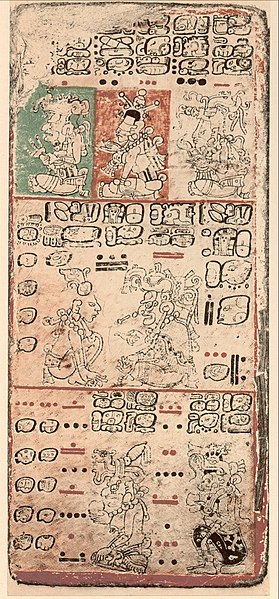They don't really seem to go together.
"As the biggest library if it is in disorder is not as useful as a small but well-arranged one, so you may accumulate a vast amount of knowledge but it will be of far less value to you than a much smaller amount if you have not thought it over for yourself. " Arthur Schopenhauer (1788-1860) German philosopher
Friday, October 28, 2011
A Fighting Librarian?
Labels:
Assyria,
Catherine Hawkley,
library,
written knowledge
Wednesday, October 26, 2011
The case of the Mayan codices
History has left us clues about Mayan codices. What can we find out about Mayan codices from these clues?
Parts of the writing on Mayan vases follows specific patterns which name the owner or patron of the piece and his titles. This pattern is also evident in the codices.
Additionally, some Mayan vases depict scribes making and writing on codices. We learn more about how Mayans made codices from these images.
Additionally, Spanish book-making and the Spanish alphabet took over Mayan paper- and book-making processes. The missionaries placed great importance on the printing press to make books for proselyting.
Antrhopologists Victor von Hagen and Hans Lenz in the 1940s independently observed descendants of Mayans making paper--the same way their ancestors did. They learned that paper was "bark-cloth"--a material made from tree bark fiber and solidified with oil.
There are only four Mayan codices left, and all of these are incomplete and partially deteriorated. Evidence shows that these four are probably copies, made when the condition of the originals were no longer sustainable. This suggests that Mayan codex-making is a more ancient practice than we realize.
We also learn from the surviving codices the page formatting. Long pages were folded to create many pages. The longest page of the four surviving codices measures over 22 feet, folding into 112 pages.
The Construction of the Codex...
Maya codices
Barkcloth
VASES
 |
| Mayan vase depicting scribes. (Source.) |
Additionally, some Mayan vases depict scribes making and writing on codices. We learn more about how Mayans made codices from these images.
SPANISH MISSIONARIES
Sixteenth-century Spanish missionaries in Central America deliberately destroyed codices they found. They were concerned that the presence of these books would distract the would-be converts or remind them of their "pagan past." Most codices sent back to Europe were damaged or discarded en route.Additionally, Spanish book-making and the Spanish alphabet took over Mayan paper- and book-making processes. The missionaries placed great importance on the printing press to make books for proselyting.
1940s OBSERVATIONS
 |
| Von Hagen with his wife. (And a vicuña.) (Source.) |
CODICES
 |
| A page from a Mayan codex. (Source.) |
We also learn from the surviving codices the page formatting. Long pages were folded to create many pages. The longest page of the four surviving codices measures over 22 feet, folding into 112 pages.
CONCLUSION
We still have much to learn about codices, but vases, the visitation of Spanish missionaries, modern observations, and surviving codices teach us much about the content, format, construction, and history of Mayan codices.The Construction of the Codex...
Maya codices
Barkcloth
Tuesday, October 25, 2011
Star light, star bright
 |
| Citizen AV3006-09E (Retail $1200). Can't my star disk do this too? |
The Great What if ...
As I perused through some of my favorite topics and how I might keep your attention for my limited space I jumped across at least ten topics before I was struck with that sense of 'we really have it good' in comparing today's amenities with those past. Take your wristwatch for example, how cool it would have been to show an ancient Egyptian the glow-in-the-dark button that tells you exactly what time it is. We would have glow in the dark Egyptian obelisks today! What a neat thing that they recorded numbers and data in places so that they could predict the time. Now, allow me to be your sales representative as we head off into the showroom floor and view some spectacular devices.
Monday, October 24, 2011
Cathedrale Notre Dame de Paris
I remember going to the movie theatres as a young child and watching this for the first time:
I'm sure as a 3 or 4 year old, I mostly enjoyed this gorgeous film for its silly gargoyles and upbeat songs like "Topsy Turvey" and "A Guy Like You." However, in more recent years, I have gained a deeper appreciation for the real story of The Hunchback of Notre Dame. I'm not talking about the story presented in the Disney film (although it is a wonderful story and among my absolute Disney favorites); I'm talking about the story that actually accompanies the true subject of Victor Hugo's original novel: Notre Dame herself.
Labels:
Architecture,
Kacee Hill,
Notre Dame de Paris,
Paris,
written knowledge
Subscribe to:
Comments (Atom)


